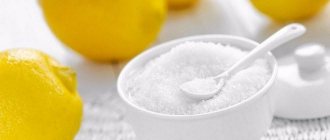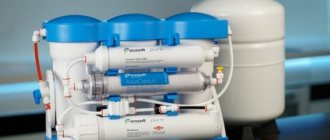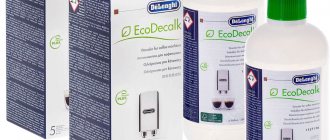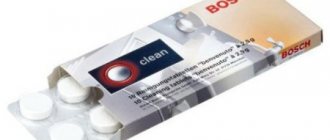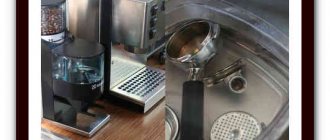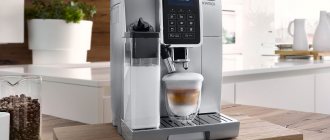Causes of scale
The cause of limescale is the hardness salts CaCO3 and MgCO3 (salts of rare earth metals calcium and magnesium) that are poorly soluble in water. These compounds are formed by heating bicarbonates Ca(HCO3)2 and Mg(HCO3)2, which are part of natural water and decompose at temperatures above +40 ºС.
Ca(HCO3)2 = CaCO3 + H2O + CO2;
Mg(HCO3)2 = MgCO3 + H2O + CO2.
If you install an ion exchange filter or a device that magnetizes water on the incoming water pipe, you can significantly reduce the deposition of hardness salts on heaters and extend the service life of not only the coffee maker, but also the boiler, kettle, washing machine and dishwasher.
Signs of a clogged coffee maker
When using water containing hardness salts, scale will inevitably form in the coffee maker. Both simple drip and capsule or carob coffee makers are susceptible to clogging.
The more bends and smaller the diameter of the tubes for the passage of water in the coffee maker, the greater the likelihood of scale formation. Lime scale particles clog water flow channels.
Not all coffee makers are equipped with a built-in indicator (a counter for the number of cups of coffee brewed), so you need to be able to recognize signs of limescale deposits inside the machine:
- It takes longer to prepare one serving of drink than before;
- if the tube and outlet are clogged, the stream of ready-made coffee becomes thin, causing the cup to take longer to fill;
- the taste of the drink has deteriorated;
- there is a foreign smell;
- the operating device began to make unusual sounds;
- a light gray sediment is visible in the cup;
- Electricity consumption has increased while the coffee maker is operating.
According to repair specialists, boiler-type capsule and carob coffee makers are most susceptible to heater overgrowth and tube clogging. In devices with a thermoblock, water does not stagnate, and the process of scale formation proceeds more slowly.
If limescale deposits have appeared, you need to get rid of it, and descaling the coffee maker is also possible at home.
In very advanced cases, the coffee maker will have to be disassembled
The need to clean the coffee machine
The tap water used to make coffee contains various chemical elements and compounds. When heated, potassium, chlorine, calcium, iron and other chemicals dissolved in the liquid react and form limescale, which falls into the drink in whitish flakes. It spoils the taste of the drink and damages the internal parts of the device. The scale that settles inside the coffee machine has a porous surface on which bacteria settle and begin to rapidly multiply.
Important! The largest amount of scale on the inner walls of a capsule coffee machine is formed by calcium compounds. In this regard, cleaning is often also called decalcification.
To understand when it’s time to descale your coffee machine, pay attention to the following factors:
- the smell of the drink changed for the worse, mustiness appeared;
- The strength of the coffee has decreased and it does not brew well;
- there was a noticeable decrease in steam pressure;
- During operation, the device makes strange sounds.
Some modern models are equipped with special sensors. The machine itself analyzes its condition and, if necessary, it gives the owner a signal that it is time to get rid of lime deposits.
Professional and folk remedies for cleaning coffee makers
Coffee machine manufacturers have long created a separate source of income for themselves: they produce and sell products for descaling devices. The latest generation models have an auto-cleaning function with the obligatory use of a proprietary product. After brewing 200-300 cups of coffee, the smart unit signals that it's time to clean. Professional products are produced in the form of tablets, powders and liquids.
Each coffee machine manufacturer claims that only branded products can be used. This is nothing more than a marketing ploy. If you read the ingredients on the label, it becomes clear that the main component is citric acid. Is it worth spending a lot of money (from 1000 to 1200 rubles) on purchasing a branded product when a packet of citric acid costs several times less and is sold in any grocery store?
Using food-grade citric acid to descale a coffee maker has a number of advantages:
- citric acid does not cause environmental pollution and does not release toxins;
- the process of dissolving limescale formations occurs gently, without releasing hazardous chemicals harmful to health;
- To dissolve even long-standing formations, you need a small amount of acid in the form of crystalline powder (30 g per 1 liter of water).
Coffee machine descaling products
If you want to drink delicious coffee and extend the life of the device, it is important to get rid of limescale deposits in a timely manner. To do this, it is not necessary to take the device to a service center if the case is not completely advanced.
Manufacturers of coffee machines offer consumers a wide range of decalcification products, which are available in the form of liquids, powders and tablets. In addition to professional ones, folk methods of cleansing are popular.
Cleaning the body, tray, container and cappuccino maker
Simply wipe the body with a soft damp cloth, rinse the tray and container under the tap with a sponge. When cleaning the cappuccino maker, place the liquid collection tube in a container of water and turn on the hot steam supply.
Clean water flowing out of the tube means cleaning is complete.
Folk remedies
When spending the family budget economically, the question arises of how to properly and cost-effectively rinse an electric plastic coffee maker.
Since special means for cleaning limescale are often expensive, use folk recipes. There are two ways to descale your coffee maker using available products.
Lemon acid
Cleaning your coffee machine from limescale with citric acid will seriously save your budget, since a bag of the product costs a penny. When heated, the substance does not form toxic compounds and has no pungent odor.
Cleaning algorithm:
- Stir 3-4 tsp in 1 liter of clean water at room temperature. citric acid powder until completely dissolved. Pour the solution into a water container.
- If there is a button to start self-cleaning, press it; if not, turn on the coffee preparation mode.
- After using half of the prepared solution, turn off the coffee maker for 10-15 minutes to soften the deposits.
- Turn on the coffee maker again and distil the remaining half of the solution.
- After using all the cleaning solution, turn off the coffee maker and rinse the removable parts under running water.
- Pour clean water into a container and run it through the coffee maker 2-3 times to remove any remaining acid.
- Prepare 2-3 cups of coffee and pour them out.
Acetic acid
Every housewife has vinegar in her kitchen, always at hand and affordable. But when heated, it produces toxic fumes; cleaning must be done in a ventilated area. Vinegar 9% is diluted with water in a ratio of 1:3. The cleaning algorithm is the same as when using citric acid, but to remove acid residues, clean water must be run through the coffee maker 5-6 times.
Despite the obvious cheapness and accessibility of cleaning coffee machines from scale with vinegar and citric acid, experts do not recommend using them often, since aggressive substances can damage the rubber parts of the parting.
Important ! Acetic acid has a strong odor, so it will take longer to rinse the coffee maker with clean water to prevent the coffee from having a vinegary taste and smell.
Special decalcifiers
Each manufacturer of coffee machines has a list of related products, which includes branded decalcification products. They are produced in the form of tablets, capsules for capsule coffee makers, powders and liquids.
Decalcifying tablets, capsules, powders
The tablets contain maleic and sulfamic acids, baking soda and a corrosion inhibitor. The product is designed specifically to clean the coffee maker from limescale deposits.
The products can be identified by the labels on the packaging:
- descaling;
- CALC;
- decalcifier;
- descaling;
- for decalcification.
Algorithm for using tablets and powder:
- Fill the tank with water up to the internal “max” line.
- Add a tablet or powder to the tank in the amount specified in the instructions, wait until completely dissolved.
- Press the black coffee button.
- Turn off the device for 15 minutes after filling the cup halfway.
- Turn on the device again to pass the second half of the solution.
- Clean the brewing unit.
- Repeat brewing twice without a tablet, with clean water.
The decalcifier capsule in a capsule coffee maker is installed in the slot for coffee capsules when the water container is filled to the maximum, then by pressing the start button, the water passes through the container with the cleaning agent and washes off the scale. The remaining actions follow the algorithm for using tablets.
Attention ! If the coffee maker has a container for ground coffee, fill it with clean water and place the tablet in it.
Liquid decalcifiers
Chemicals and universal products of this kind are produced by the brands Topper, Top House, Swipl, Delonghi, and they are not cheap. Similar universal descaling products, for example, SAECO or Kumkumit, will cost much less and will produce decalcification with the same result as branded ones.
General instructions for use:
- Prepare the cleaning solution according to the instructions on the package and pour it into the water container up to the “max” line.
- Select the automatic cleaning function on the display if it is available in the device, then the device will do everything itself.
- If there is no self-cleaning function, start the device and immediately open the tap, from which 150 ml of solution should flow out.
- Repeat the procedure 4-5 times every 5 minutes, draining 100 ml of solution.
- After finishing the cleaning solution, rinse the container under the tap several times and pour cold water into it;
- Repeat point 3.
- Wash the working unit of the system.
Instructions for descaling different types of coffee makers
The method for descaling a coffee maker depends on the design of the device. Machines with a removable filter and brewing unit can be easily washed under the tap in running water. If you regularly wash the device after making coffee, then thorough cleaning with citric acid or store-bought tablets can be done no more than once a month.
Models with a built-in unit often have an auto-cleaning (decalcification) function, and if it is not provided, the scale is removed independently using a cleaning solution.
Most modern products are based on citric acid.
Descaling a drip coffee maker
- Wash the filter with warm water and a soft brush (unnecessary toothbrush) and return it to its place.
- Prepare a working liquid from citric acid: dissolve 30 g of crystalline powder in 4 glasses of warm water.
- Pour the solution into the water tank. Add cold water to the tank up to the Max mark.
- Turn on the coffee maker for 5-10 minutes. After 30 minutes, repeat the procedure and wait until the entire solution passes into the receiving flask.
- If there are still traces of scale on the filter, dip it in a hot solution prepared in the indicated way and hold for an hour.
- Rinse the filter well and replace it.
- Run clean water through the coffee maker several times until the acid comes out completely.
Citric acid can be replaced with vinegar. To do this, use white table vinegar with a strength of 9%, dissolved in water in a ratio of 1:2.
If the glass vessel for collecting the finished coffee becomes cloudy, you need to fill it with a warm solution and rinse thoroughly after 30 minutes with water.
How to clean
For descaling, it is strongly recommended to use the recommended cleaning products for your specific model. This procedure is carried out especially quickly and comfortably in automatic mode. Top-class coffee machines have an auto-cleaning function.
The most common reason for shortening the service life of an appliance is scale formation.
Professional cleaning products for coffee makers
The instructions for each device contain a cleaning clause, which you must read and follow the manufacturer's recommendations. There is nothing difficult to understand how to clean your model of coffee maker.
It is important to remember that a change in the taste of the drink is the first sign of the presence of scale, particles of which enter the drink and form sediment at the bottom of the cup.
The basic principle of decalcification of all coffee machines is to fill the water tract with an acidic environment. It interacts with scale, which, when dissolved, comes out of the equipment along with the liquid. After this, it is necessary to rinse the tract several more times with clean water.
Liquid decalcifiers must be poured into the machine tank in the amount specified in the instructions. Their main difference from tablets is that they do not emit toxic fumes. The products are completely safe and include: citric acid, sodium salt and other mild chemical elements.
Companies often offer special cleaning products for their coffee machines, as they are designed taking into account the characteristics of the manufacturer.
When using tablets, the cleansing procedure begins only after they are completely dissolved. Their basic composition is similar to liquid products. One tablet is enough to get rid of scale.
The more expensive the coffee machine, the more common sense it is to use expensive professional products specified by the manufacturer for a specific model.
Liquid decalcifiers are dissolved according to the instructions, poured into a container and “driven” through the machine.
I would like to highlight two universal products.
- Durgol - although it is expensive, it is the most gentle and universal, suitable for any equipment. Manufacturer – Switzerland.
- Glutoclean – for cleaning food equipment, very economical packaging.
A universal product designed to take into account the fact that the design of the coffee machine contains delicate metal or plastic parts.
Folk remedies
Folk remedies can also be used for cleaning, but in expensive models, tablets, powder and gel will still be more suitable.
In order to descale your favorite coffee maker at home, both vinegar and citric acid can be useful.
You can buy the products at any supermarket, and the cost is much lower than that of special products.
For the first method, you need to mix one part white table vinegar with two parts water. For more severe contamination, you can prepare a stronger solution (all elements in equal parts).
For the traditional method with citric acid, you need to mix 4 cups of hot water with 30 grams of citric acid, add 4 cups of cold water to the resulting solution.
The cleaning process will take no more than 30 minutes and will consist of 3 stages: descaling and two rinsing cycles.
Scale can be removed even without using any means. Under one condition - for this it is necessary to disassemble the device after each use and wipe all parts with a damp cloth.
Features of cleaning different types of coffee makers
Water always contains metal salts, most often calcium and magnesium carbonates. The substances are obtained during a thermal process and remain on the surface of the coffee machine elements. You will notice that the drink takes longer to obtain than before, there is an unpleasant taste or aroma, and sediment forms in the mug. According to experts in the repair of household appliances, boiler-type carob and capsule coffee makers are most prone to clogs.
How to Clean a Drip Coffee Maker
Drip coffee makers are very common due to their low price, but they will also have to be cleaned regularly. Do the following:
- take an old toothbrush and scrub the filter;
- Dilute 20 g of citric acid in 500 ml of water, pour the liquid into a water container. Add the level to the maximum mark;
- turn on the toggle switch so that the coffee maker switches to operating mode and leave the device for 5-20 minutes;
- repeat the cleaning procedure after half an hour.
After this method, there should be no traces of scale left. If the coffee machine has never been cleaned before, the source of contamination may be large. In this case, you need to remove the filter, leave it in hot water with citric acid for half an hour, then rinse it and put it back in its original place. Then start the coffee maker in normal mode, after filling it with clean water.
How to descale a coffee maker
You can remove scale using citric acid, vinegar, and soda. These products destroy even stable compounds. You can clean the coffee maker using this method every 200 cups or as it gets dirty. When preparing a solution, first pass the water through a filter to remove metal salts. With regular cleaning, the device will delight you with delicious, aromatic coffee for many years.
Lemon acid
The most popular descaling agent is citric acid. For 4 glasses of water, take 30 g of dry substance, dissolve and pour into the liquid reservoir. Add cold water to the maximum level, turn on the device for 10 minutes. After half an hour, repeat the procedure. If you brew coffee after cleaning and notice a sour lemony taste, rinse the coffee maker a couple of times with plain water.
Vinegar
Vinegar has a similar effect as citric acid. Take a 9% solution in an amount of 100 ml, dilute it with water 3 times. Then pour the liquid into the reservoir. Turn on the coffee maker and leave for 15 minutes to descale. Drain the remaining liquid and rinse the container with water. For greater efficiency, you can mix vinegar with citric acid (30 g of lemon and 3-4 tablespoons of vinegar per 500 ml of water), such a solution will cope even with severe salt deposits.
Salt and soda
You probably always have baking soda and salt in your kitchen, so you can make an excellent cleanser out of them. Mix a tablespoon of each substance and add 400 ml of water. Pour the solution into the liquid compartment, where scale accumulates, and leave to act for a couple of hours. Then drain the solution, rinse the container with clean water, and you can put the cleaned device into operation.
Review of household products
Coffee machine manufacturers produce concentrates and tablets for cleaning the system. The choice depends on the model and type of device. They can be purchased at hardware stores. The most popular are cleaning fluids from Bork, Saeco, Krups, tablets from Bosch, Siemens. When purchasing, purchase only original products and follow the recommendations specified by the manufacturer in the instructions. The order of use of cleaning powders, liquids and tablets is given on the packaging of the products.
Purchased funds
Liquid
Manufacturers of coffee makers and coffee machines produce liquid descaling products. They take into account the specific features of the models, are gentle on internal parts and eliminate plaque of any thickness.
The liquid that removes scale is based on acids. They react with salts and dissolve them.
Use the liquid immediately; it does not require additional additives. Pour it into a water container. The exact amount depends on the brand of coffee maker and is indicated in the instructions.
Interesting! Top 7 best descaling products for coffee machines
Rinse the water container before brewing coffee.
Disadvantages of the product: high cost from 300 to 1500 rubles. Branded drugs are only suitable for a specific model. Universal liquids are used for any device. Their cost is 20% lower.
What would you use?
With purchased funds With what you have at home
Pills
Two types of tablets are available: for descaling and for cleaning coffee oils.
The basis of the product is active acid and sodium bicarbonate. Tablets are produced with an environmentally friendly composition from natural biodegradable substances.
Advantages: efficiency, compactness and availability in stores.
The instructions for the tablets indicate what types of coffee makers they are suitable for. The product completely cleans the device of plaque and does not harm internal parts.
Dissolve the tablet in water and pour the liquid into the reservoir. Afterwards, rinse it with water.
How to use Auto Clean mode
Expensive models of coffee machines have a very convenient function - auto-cleaning. If your device has such an advantage, be sure to use it. Read the instructions first; the procedure should be outlined there. Then turn on the coffee maker, find the auto-clean button and press it.
After receiving the command, the machine will perform self-cleaning. You will periodically need to add clean water and follow the commands displayed on the display. Typically, the manufacturer recommends self-cleaning every 100-150 cups.
Instructions for BOSCH coffee machines
| Instructions for coffee machine Bosch TES50129 |
| Instructions for coffee machine Bosch TES50221RW/502.. (VeroCafe) |
| Instructions for coffee machine Bosch TES50321 |
| Instructions for coffee machine Bosch TES50324 |
| Instructions for coffee machine Bosch TES50328 |
| Instructions for coffee machine Bosch TES50621/50628 |
| Instructions for coffee machine Bosch TES 55236/552.. (VeroCappuccino 200) |
| Instructions for Bosch TES552 coffee machine |
| Instructions for coffee machine Bosch TES 556M1/559.. (VeroCappuccino 600/900) |
| Instructions for coffee machine Bosch TES 70121 |
| Instructions for coffee machine Bosch TES70129 |
| Instructions for coffee machine Bosch TES70321 |
| Instructions for coffee machine Bosch TES 71221RW../715.. (VeroBar AromaPro 100/300) |
| Instructions for Bosch TES713F1 coffee machine |
| Instructions for coffee machines Bosch TES71621 |
| Instructions for coffee machine Bosch TES 70621 |
| Instructions for coffee machine Bosch TES80329RW /805../807..(VeroSelection 300/500) |
| Instructions for coffee machine Bosch TCA5201 |
| Instructions for coffee machine Bosch TCA5309 |
| Instructions for coffee machine Bosch TCA5401 |
| Instructions for coffee machine Bosch TCA5601 |
| Instructions for coffee machine Bosch TCA5608 |
| Instructions for coffee machine Bosch TCA5802 |
| Instructions for coffee machine Bosch TCA5809 |
| Instructions for coffee machine Bosch TCA6001 |
| Instructions for coffee machine Bosch TCA6301 |
| Instructions for coffee machine Bosch TCA6401 |
| Instructions for coffee machine Bosch TCA6701 |
| Instructions for coffee machine Bosch TCA6709 |
| Instructions for coffee machine Bosch TCA6801 |
| Instructions for coffee machines Bosch TCA6809 |
| Instructions for coffee machine Bosch TCC78K750 |
| Instructions for coffee machine Bosch TIS30321/30129 (VeroCup 100/300) |
How not to clean a coffee maker
The process of cleaning a coffee maker seems simple, but it has a number of features. If you make mistakes, you can damage the device, so never do the following:
- If you use special cleaning solutions to remove scale deposits, do not add other substances to them. Branded mixtures are already produced at the required concentration, and changing it will make cleaning ineffective;
- do not use abrasive substances and products when cleaning work surfaces, they leave a lot of scratches;
- Do not use tap water for cleaning; it contains a high concentration of salts, so there is no point in cleaning scale with it. Buy bottled water or use a pre-filter system.
With regular cleaning, even the most inexpensive coffee maker will last you a long time, so don't neglect the process. Do not wait until the machine breaks down; carry out preventive measures against scale formation in a timely manner. Careful operation of the device is the key to obtaining a tasty drink.
More and more connoisseurs of the true taste of coffee prefer household coffee machines (they are also called espresso or carob coffee makers). If you use a coffee maker every day, then over time the taste of the coffee may deteriorate, this is due to the accumulation of scale from the ingredients used.
Summarize
The coffee machine itself will let you know when it is time to start cleaning. You just need to monitor the water hardness. If the machine gives a signal that the device is dirty, you cannot put it off; you need to carry out the procedure on time. Timely cleaning of the device will allow you to save money and return the taste to its original shades.
In order to spend less time cleaning, you can use filtered or bottled water. If you want to rid your machine of scale, you should follow the instructions.
It is not necessary to use the cleaning products indicated in the instructions if you do not have them on hand. Citric acid may be suitable. Due to its composition, it will not have a harmful effect on the body either for you or your family. In addition, citric acid is much cheaper than advertised coffee machine cleaning products.
If you have problems with your cappuccino maker, then you cannot do without cleaning, since milk fat can adversely affect the operation of the machine.
If your machine does not form a tablet or does not form normally. Then you should look for problems and resolve the issue urgently.
How to clean a carob coffee maker?
The operating instructions describe in detail the process of cleaning a carob coffee machine. Special means are used to remove scale that has formed.
Most carob coffee makers do not have cleaning systems. Therefore, you will have to carry out the cleansing yourself. At the end of the brewing process, you need to rinse the horn under running water, do not forget the drink in the horn. Once a month, you need to put a cleaning tablet into the coffee horn to remove fats from coffee, turn on the coffee maker to brew the drink (to soak the tablets). As soon as water starts flowing from the nozzles, stop the water supply. This cleaning is carried out for 15 minutes. Once all the dissolved deposits are gone, pass water through the horn, up to two liters. To remove scale, add a special product into a half-filled bunker compartment (according to the instructions on the package), pass the solution in small doses for half an hour. Then rinse with water (2-3 liters).
When is your coffee machine required to be serviced?
Despite the fact that most owners install multi-stage water filters, it is almost impossible to achieve perfect purity. Minerals and metals contained in tap water are deposited on working components over time, resulting in an urgent need to remove scale and get rid of harmful microorganisms living in it.
Naturally, it is impossible to detect the presence of plaque on the internal components of the device with the naked eye, but there are several of the most obvious signs indicating that it is time for the next cleaning:
- If the coffee machine is equipped with a counter for prepared portions of the drink, then when they reach a certain number (200-250, depending on the model), the device automatically signals the need to turn on the cleaning program, or turns it on itself.
- The device takes longer than usual to heat water and prepare drinks slowly.
- Remains of limescale get into the cup.
- The device operates noisily and extraneous sounds are heard during operation.
- The taste of coffee has bitter, metallic shades.
In addition, due to scale formation on the heating element, energy consumption may increase significantly.
In addition to minerals and metals deposited on the heating element, coffee fats gradually settle on the walls of the tubes of the device, forming a film over time. Particles of coffee beans fall into microscopic crevices in the plastic and rubber parts of the coffee machine, causing the rapid proliferation of pathogens.
Thus, a device used at home requires comprehensive cleaning on average once every six months.
How to clean a coffee maker filter?
- First you need to clean the filter of debris.
- Then rinse the filter with warm water and place it in the coffee maker.
- The next step is to prepare the solution: mix one part vinegar with two parts water.
- Pour the solution into the container and turn on the coffee maker, as for making a cup of coffee.
- Leave the solution in the car for 15 minutes.
- Then remove the filter and drain the product.
- After the coffee maker has cooled, rinse the flask thoroughly with warm water.
- The washing process must be repeated, but with cold water. If the odor remains after rinsing, rinse the coffee maker again.
- Now you can make a cup of coffee.
Attention!
Under no circumstances should you use a solution containing soda. Such a solution can damage the filter.
How to clean a coffee maker with citric acid?
One of the popular descaling methods is the folk one - using citric acid.
So, to clean the coffee maker with citric acid: dilute 30 ml of powder with 4 glasses of hot water, mix well and pour into the coffee maker compartment. Then add about four more glasses (cold water). Then turn on the coffee maker and wait until half of the mixture flows out; let the remaining liquid remain in the compartment for a while. After about half an hour, the process must be repeated until the solution is completely drained. You can get rid of the lemon taste in coffee using ordinary water; to do this, run clean water through the coffee maker several times.
With proper care, the service life of the coffee maker is extended, because a considerable number of malfunctions are associated with the fact that something becomes clogged or jammed due to calcium deposits. Do not neglect the rules of operation of the coffee maker, and every day it will delight you with a strong, tasty and aromatic drink.
